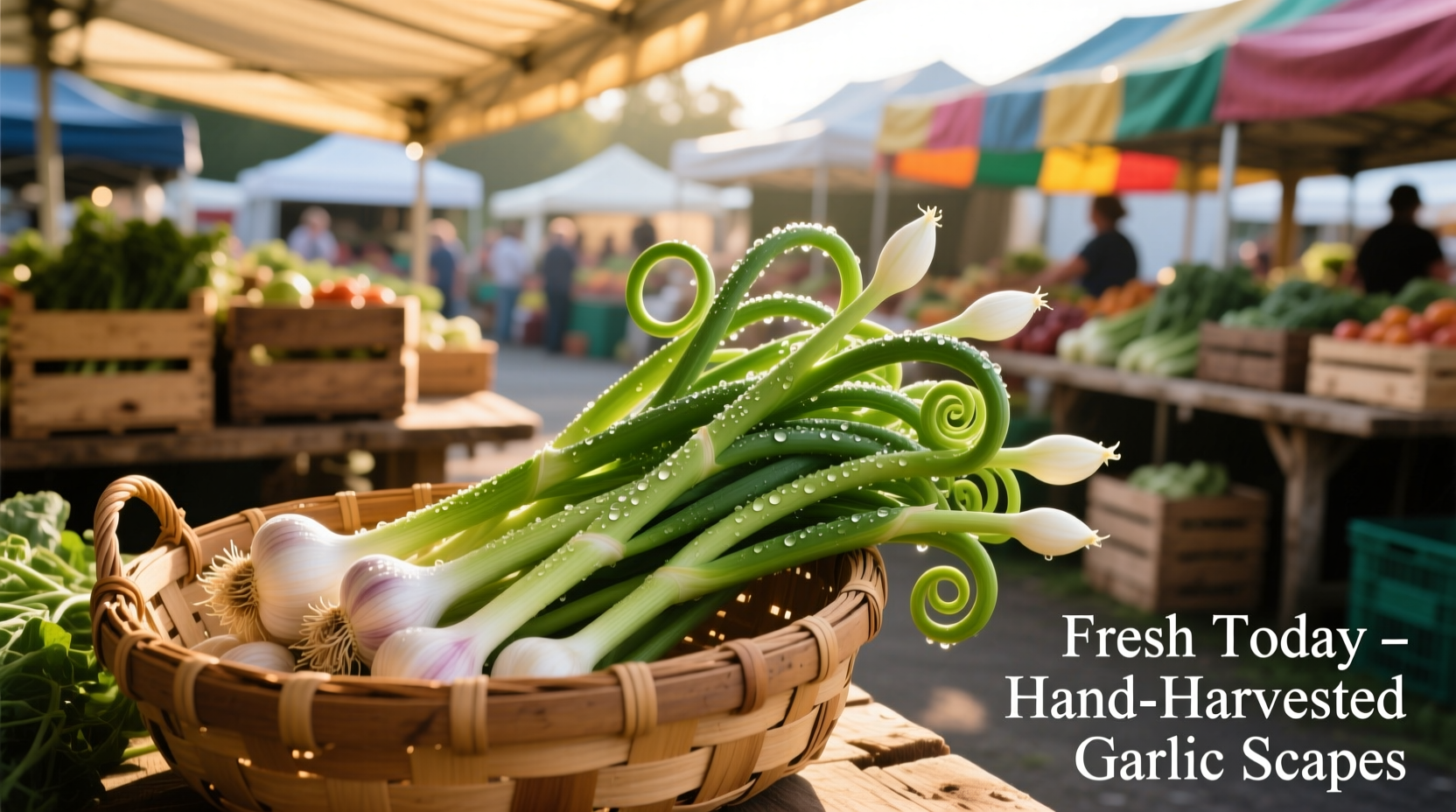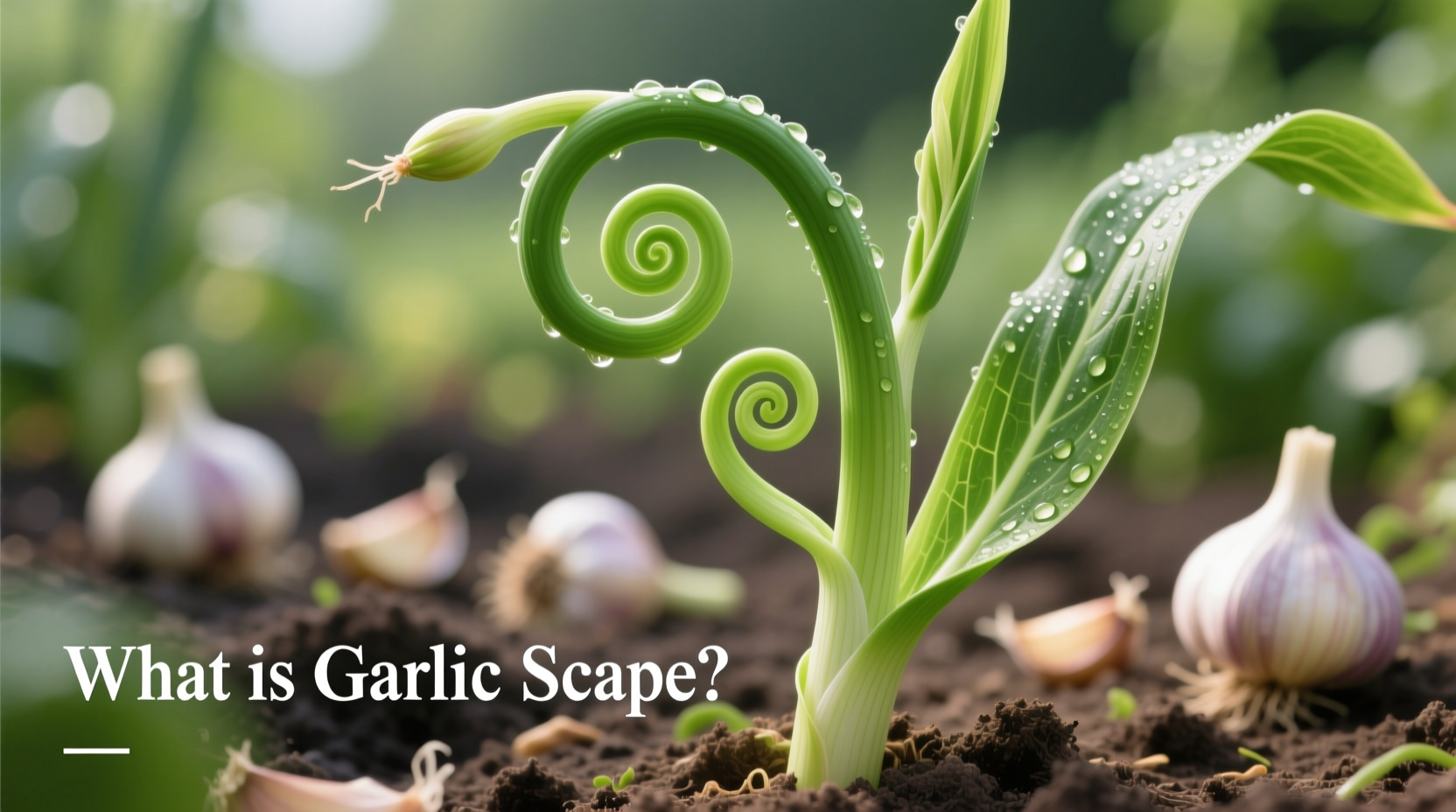Garlic scapes are the curly, green flowering stalks that grow from hardneck garlic plants before they produce bulbs. These edible stalks offer a milder garlic flavor than cloves and are harvested in late spring to early summer when they form a distinctive spiral shape. Chefs prize them for their versatility in cooking, nutritional benefits, and seasonal availability as a spring delicacy.
Have you ever spotted those curly green stalks at your farmers' market and wondered what is garlic scape? You're not alone. Each spring, curious home cooks discover these unique garlic plant parts and want to know how to identify, use, and enjoy them. This comprehensive guide delivers everything you need to know about garlic scapes—from their botanical origins to practical cooking techniques that maximize their delicate flavor.
Understanding Garlic Scapes: Nature's Spring Gift
Garlic scapes represent the flower stalk of hardneck garlic varieties (Allium sativum var. ophioscorodon). Unlike softneck garlic commonly found in supermarkets, hardneck varieties send up these distinctive stalks as part of their reproductive cycle. Farmers harvest scapes when they form that characteristic curl—typically 30-45 days before the garlic bulbs mature. This harvesting practice serves two purposes: it directs the plant's energy toward bulb development and provides a valuable secondary crop.
| Garlic Component | Harvest Time | Flavor Profile | Primary Use |
|---|---|---|---|
| Garlic Scapes | May-June (spring) | Mild, grassy, with subtle garlic notes | Fresh cooking, pesto, stir-fries |
| Garlic Bulbs | July-August (summer) | Strong, pungent, complex | Raw or cooked applications |
| Garlic Greens | Early spring | Very mild, similar to chives | Garnish, salads, light cooking |
Garlic Scape Development Timeline
Understanding the garlic scape lifecycle helps you identify the perfect harvest window. Hardneck garlic follows this seasonal progression:
- September-October: Plant garlic cloves in well-drained soil
- March-April: Garlic greens emerge (resembling chives)
- May: Scapes begin forming as straight stalks
- Early June: Scapes develop their signature curl (ideal harvest time)
- Late June: Scapes straighten if not harvested
- July-August: Garlic bulbs mature for harvest
According to agricultural research from University of Minnesota Extension, harvesting scapes when they complete their first full curl maximizes both scape quality and bulb development. Delaying harvest beyond this point results in tougher, fibrous scapes and smaller bulbs.

Identifying Quality Garlic Scapes
When selecting garlic scapes, look for these characteristics:
- Color: Vibrant green without yellowing
- Texture: Firm and crisp, not limp or rubbery
- Shape: Distinct curl formation (not yet straightened)
- Thickness: Uniform diameter from base to tip
Quality scapes should snap cleanly when bent, similar to fresh asparagus. Avoid specimens with brown spots, mushy areas, or excessive dryness at the cut end.
Culinary Applications: Maximizing Flavor Potential
Garlic scapes offer remarkable versatility in the kitchen. Their milder flavor compared to garlic cloves makes them suitable for raw applications where regular garlic would overpower a dish. Professional chefs recommend these techniques:
Preparation Methods
- Chopping: Remove the tough flower bud end, then slice crosswise into thin rounds
- Blanching: Dip in boiling water for 30 seconds to preserve color for freezing
- Grilling: Toss with oil and grill whole for smoky flavor enhancement
Top Recipe Applications
- Garlic scape pesto (substitute for basil)
- Stir-fries (add in last 2 minutes of cooking)
- Omelets and frittatas (use raw or lightly cooked)
- Pickled scapes (preserves for year-round use)
- Infused oils (steep in olive oil for subtle garlic flavor)
Research from the Rutgers New Jersey Agricultural Experiment Station confirms that garlic scapes contain allicin—the same beneficial compound found in garlic cloves—but in lower concentrations, explaining their milder flavor profile.
Nutritional Benefits Worth Noting
While not as intensely studied as garlic bulbs, garlic scapes offer notable nutritional advantages:
- Rich in vitamin C (more than garlic bulbs)
- Contains dietary fiber for digestive health
- Provides vitamin A and K
- Contains antioxidants including selenium
- Lower in calories than garlic bulbs (approximately 20 calories per 100g)
According to USDA nutritional data, garlic scapes deliver these nutrients while maintaining that delicate flavor profile that makes them so versatile in spring cooking.
Storage Techniques for Maximum Freshness
Garlic scapes have a relatively short shelf life compared to garlic bulbs. Follow these storage methods:
- Refrigeration: Store in a loosely closed plastic bag in the crisper drawer (2-3 weeks)
- Freezing: Blanch first, then freeze in airtight containers (6-8 months)
- Pickling: Preserve in vinegar solution (1 year refrigerated)
- Oil infusion: Store in olive oil in refrigerator (2 weeks)
Avoid storing scapes at room temperature, as they'll quickly become rubbery and lose flavor. The Oregon State University Extension Service recommends using fresh scapes within 10-14 days for optimal flavor and texture.
Common Mistakes to Avoid
Even experienced cooks sometimes mishandle garlic scapes. Steer clear of these errors:
- Overcooking: They lose texture and flavor when cooked too long
- Using the entire scape: The flower bud end is often too tough for most applications
- Harvesting too late: Straightened scapes become fibrous and difficult to chop
- Storing with moisture: Excess water accelerates spoilage
Professional chefs emphasize that garlic scapes work best when treated like asparagus or green beans—added toward the end of cooking to preserve their delicate texture and flavor.
Seasonal Context: Why Timing Matters
Garlic scapes represent a true seasonal ingredient with specific context boundaries:
- Availability: Primarily May through June in most North American growing regions
- Substitutes: When unavailable, use a combination of garlic greens and mild garlic cloves
- Limitations: Not suitable for recipes requiring strong garlic flavor
- Peak usage: Best used within 2 weeks of harvest for optimal flavor
Understanding these context boundaries helps explain why garlic scapes have developed such a devoted following among seasonal cooking enthusiasts—they represent a fleeting spring delicacy that connects us to agricultural cycles.
Frequently Asked Questions
Can you eat the entire garlic scape?
While technically edible, the very end of the garlic scape (the flower bud) is often too tough for most culinary applications. Most chefs recommend removing the last 1-2 inches of the thin, pointed end before using the remainder of the scape, which has a more tender texture suitable for cooking.
How do garlic scapes differ from regular garlic in cooking?
Garlic scapes offer a milder, more nuanced flavor compared to garlic cloves—similar to the difference between chives and onion. They contain less allicin, the compound responsible for garlic's pungency, making them suitable for raw applications where regular garlic would be overpowering. Their texture is also more similar to asparagus than the dense cloves.
When is the best time to harvest garlic scapes?
The optimal harvest time is when garlic scapes complete their first full curl but before they begin to straighten out. This typically occurs in late spring to early summer, about 30-45 days before the garlic bulbs mature. Harvesting at this stage ensures the best texture and flavor while directing the plant's energy toward bulb development.
Can I substitute garlic scapes for regular garlic in recipes?
You can substitute garlic scapes for regular garlic, but you'll need to adjust quantities since scapes have a milder flavor. As a general rule, use about twice the amount of chopped scapes to achieve similar garlic intensity. Remember that scapes work best added later in the cooking process, unlike garlic cloves which often benefit from earlier addition.
Why do some garlic plants produce scapes while others don't?
Only hardneck garlic varieties produce scapes, while softneck varieties (commonly found in supermarkets) do not. Hardneck garlic is typically grown in cooler climates and produces a single ring of larger cloves. The scape represents the plant's attempt to flower and produce seeds, which is why removing it directs energy toward bulb development.











 浙公网安备
33010002000092号
浙公网安备
33010002000092号 浙B2-20120091-4
浙B2-20120091-4